Veeam Backup & Replication and PureStorage Integration
- Tutorial
Today we present a guest post from Elijah Karin.
Recently, Veeam, together with PureStorage, has released an integration plugin for Veeam Backup & Replication 9.5 with PureStorage arrays. And if you are the happy owner of the Veeam Backup & Replication Enterprise Plus license, then there is no reason not to back up your infrastructure from the snobshots of the hundred.
However, since this solution is new, in Russia and the CIS countries there is no information in Russian on how to set up the infrastructure for working with backups from hundreds of snapshots.
In my article, I will try to fill this gap.
Let's get down to business.

We have the following infrastructure:
It is understood that the array itself is already connected to the iSCSI network, the network infrastructure is raised, where the vLANs you need are already configured, vSwitch, vKernel are registered on the hosts, everything works and flourishes, but you want something else.
First of all, we need to download and install the desired plugin. You can do this in your account on my.veeam.com , in the section Downloads → Product downloads :
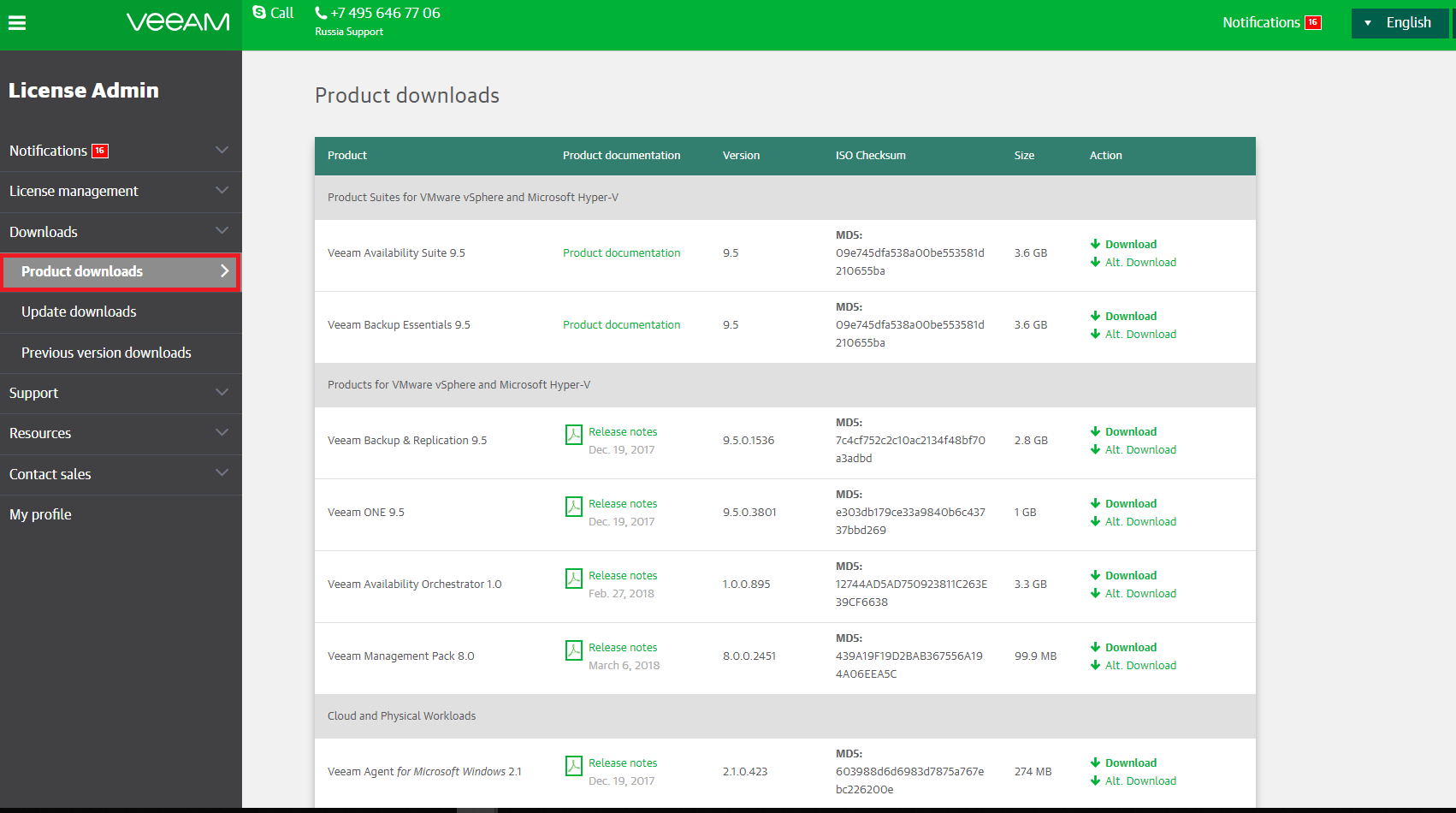
Go to the very bottom of the page, where the Pure Storage Plug-In for Veeam Backup & Replication is located .

Before starting the installation, close all windows of the Veeam console or reboot the server. There is nothing interesting in the installation of the plugin, in fact, click “next, further, further”. At the end of the installation, a reboot is required.
In our example, vmk1 and vmk2 are created on each host through which hosts communicate with the iSCSI network:

In turn, they are used in vSwitch1:

To access the virtual machine with Veeam Backup & Replication in the iSCSI network, we need to create a VM Network iSCSI (visible in the screenshot above )
To do this, in the Virtual switches toolbar :

Now you need to add 2 network adapters to our virtual machine and assign them a freshly created network.

This completes the ESXi setup.
Next, we need to configure the operating system on the machine where Veeam is installed.
1. Go to Control Panel \ Network and Internet \ Network Connections
2. Set the IP addresses from your iSCSI network for the two network cards we added.
I also set the Jumbo Frame 9000 network adapter in the settings, but this is another tale in which you need to configure other network components (the same applies to vLAN, etc.).
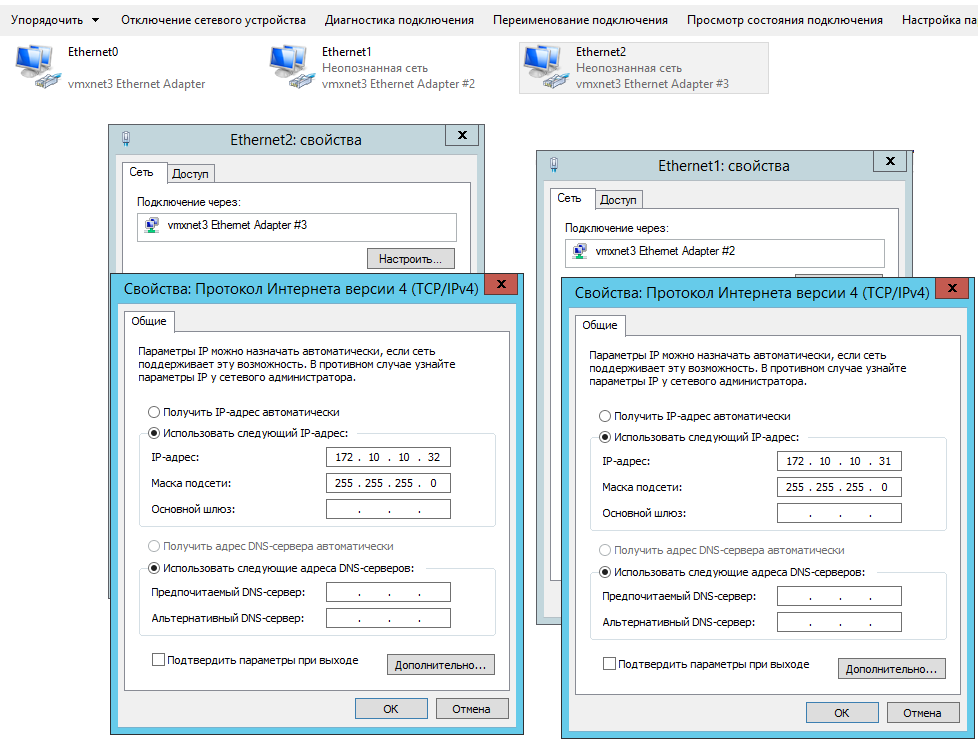
3. Using the server manager, install 2 components: MPIO and iSCSI Initiator.
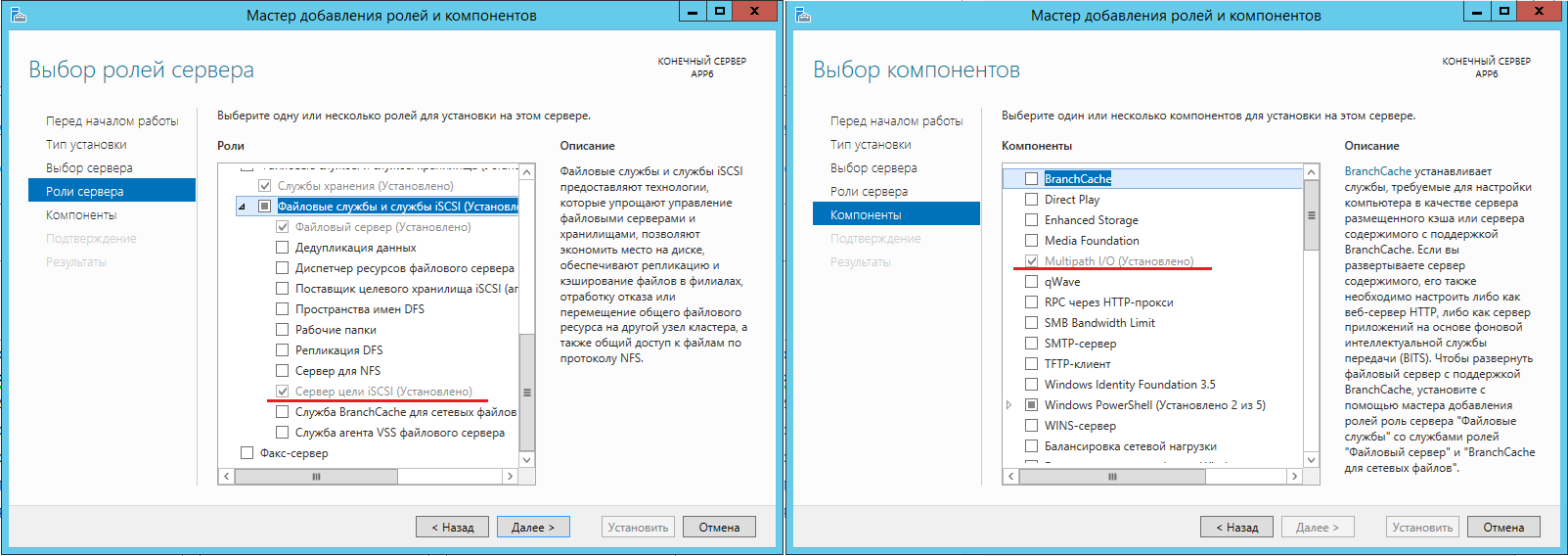
4. To add support for MPIO, open Server Manager → Tools → MPIO
5. In the dialog that opens, go to the Detect Multipath Devices tab and check the Add support for iSCSI devices checkbox , after which a reboot is required.
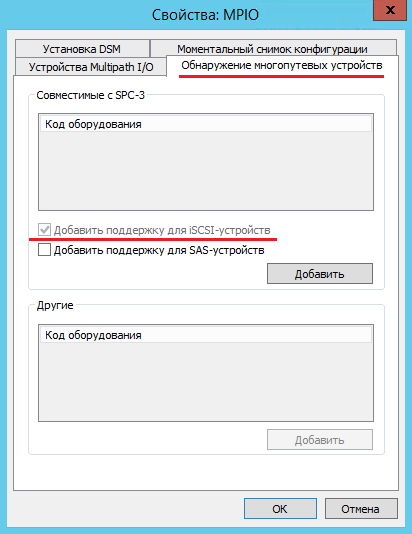
6. Now you need to configure the iSCSI Initiator. To do this, open Server Manager → Tools → iSCSI Initiator .
7. In the window that opens, go to the Discovery tab , where we click the Discover portal button ...
8. In the IP address or DNS name field, specify the IP address of the target created on the storage.
9. Click the Advanced button .
10. In the window that opens, you need to configure 2 values:
11. Repeat steps 8 to 10 as many times as necessary to connect all paths.


As a result, you should see the storage icon on the Storage Infrastructure panel , opening which you will see the LUNs created on it.
It remains to check whether the backup mode is enabled from the hundred snapshots for our jobs in the Veeam console.
You can do this by right-clicking on the task, then selecting Edit → Storage → Advanced .
On the Integration tab → select Enable backup from storage snapshots .
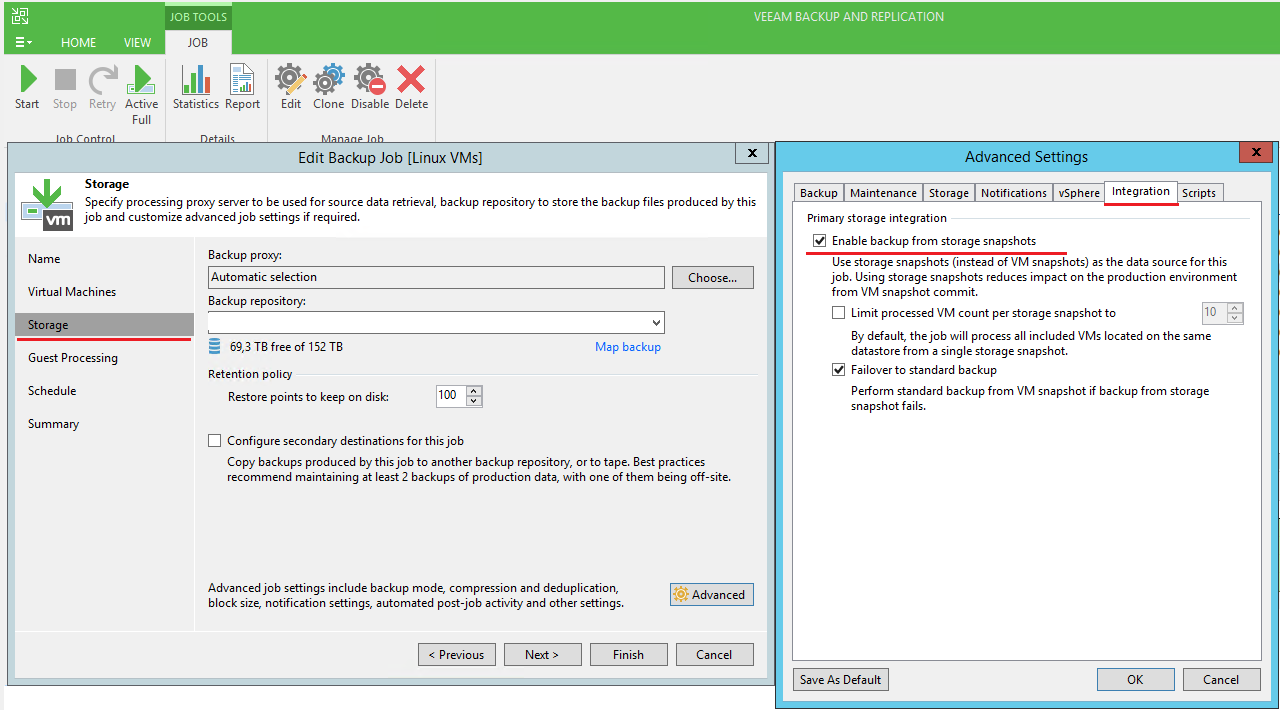
I hope you have succeeded. Thank you all for your attention!
Good afternoon, Habr! My name is Eli Karin ( Iliya_karin ). I have been dealing with all issues in the field of system administration in a large company for more than 7 years. Thanks to colleagues from Veeam for the opportunity to tell a little about my experience here.
Recently, Veeam, together with PureStorage, has released an integration plugin for Veeam Backup & Replication 9.5 with PureStorage arrays. And if you are the happy owner of the Veeam Backup & Replication Enterprise Plus license, then there is no reason not to back up your infrastructure from the snobshots of the hundred.
However, since this solution is new, in Russia and the CIS countries there is no information in Russian on how to set up the infrastructure for working with backups from hundreds of snapshots.
In my article, I will try to fill this gap.
Let's get down to business.

We have the following infrastructure:
- 4 hosts with Vmware vSphere ESXi 6.5 hypervisor
- 1 vCenter
- 1 virtual machine with Veeam Backup & Replication, it is also a Veeam proxy server
- Separate subnet for iSCSI traffic, consisting of 2 separate 10G switches
- PureStorage m20 Array
It is understood that the array itself is already connected to the iSCSI network, the network infrastructure is raised, where the vLANs you need are already configured, vSwitch, vKernel are registered on the hosts, everything works and flourishes, but you want something else.
Plugin installation
First of all, we need to download and install the desired plugin. You can do this in your account on my.veeam.com , in the section Downloads → Product downloads :

Go to the very bottom of the page, where the Pure Storage Plug-In for Veeam Backup & Replication is located .

Before starting the installation, close all windows of the Veeam console or reboot the server. There is nothing interesting in the installation of the plugin, in fact, click “next, further, further”. At the end of the installation, a reboot is required.
VMware Hosts and Virtual Machines
In our example, vmk1 and vmk2 are created on each host through which hosts communicate with the iSCSI network:

In turn, they are used in vSwitch1:

To access the virtual machine with Veeam Backup & Replication in the iSCSI network, we need to create a VM Network iSCSI (visible in the screenshot above )
To do this, in the Virtual switches toolbar :
- Click on the Add host networking icon .
- In the window that opens, select Virtual Port Group for a Standard Switch .
- Click Next .
- We select our iSCSI vSwitch, in our example it is vSwitch1 .
- Click Next .
- Set a name for our VM Network iSCSI virtual network .
- Click Finish .

Now you need to add 2 network adapters to our virtual machine and assign them a freshly created network.
- Right-click on VM, select the Edit command .
- Next, select New device → network → add
- Choosing VM Network iSCSI
- In Adapter type, select VMXNET3, we still have 10G.
- Repeat steps 2-4 again.
- Click OK .

This completes the ESXi setup.
Set OC settings
Next, we need to configure the operating system on the machine where Veeam is installed.
1. Go to Control Panel \ Network and Internet \ Network Connections
2. Set the IP addresses from your iSCSI network for the two network cards we added.
I also set the Jumbo Frame 9000 network adapter in the settings, but this is another tale in which you need to configure other network components (the same applies to vLAN, etc.).

3. Using the server manager, install 2 components: MPIO and iSCSI Initiator.
- The first is under Server Roles → File and iSCSI Services → Server → iSCSI Target Server
- You will find the second on the Components tab → Multipath I / O

4. To add support for MPIO, open Server Manager → Tools → MPIO
5. In the dialog that opens, go to the Detect Multipath Devices tab and check the Add support for iSCSI devices checkbox , after which a reboot is required.

6. Now you need to configure the iSCSI Initiator. To do this, open Server Manager → Tools → iSCSI Initiator .
7. In the window that opens, go to the Discovery tab , where we click the Discover portal button ...
8. In the IP address or DNS name field, specify the IP address of the target created on the storage.
9. Click the Advanced button .
10. In the window that opens, you need to configure 2 values:
- Local adapter - there aren’t much options here, select Microsoft iSCSI initiator
- Initiator IP - here you can make a mistake. If you have 2 (or more) different switches for iSCSI that are not interconnected, then you should know which iSCSI target to which of the switches is physically connected. For our example, this can be clarified indirectly using the ping command, first pinging all 4 (or more) storage target IP addresses, and then through another.
- I got the following correspondence:
- After 172.10.10.31, targets 172.10.10.9 and 172.10.10.12 are visible
- After 172.10.10.32, targets 172.10.10.10 and 172.10.10.11 are visible
- Accordingly, in the initiator IP address field, specify the address of the network adapter through which the corresponding target responds.
11. Repeat steps 8 to 10 as many times as necessary to connect all paths.

Getting started with Veeam Backup & Replication
- Open the main Veeam Backup & Replication console.
- Go to Storage Infrastructure → Add storage → Pure Storage . If you don’t have this item, then something went wrong during the plug-in installation phase.

Follow the prompts of the program. - Add our storage system by IP address or DNS name (from the management network, or as it is also called, management network) and click Next .
- We provide accounting programs for access to storage systems.
- We select the protocol by which we will transmit iSCSI data, leave the rest as is.
- Check the settings and click Finish .

As a result, you should see the storage icon on the Storage Infrastructure panel , opening which you will see the LUNs created on it.
We do the final check
It remains to check whether the backup mode is enabled from the hundred snapshots for our jobs in the Veeam console.
You can do this by right-clicking on the task, then selecting Edit → Storage → Advanced .
On the Integration tab → select Enable backup from storage snapshots .

I hope you have succeeded. Thank you all for your attention!
